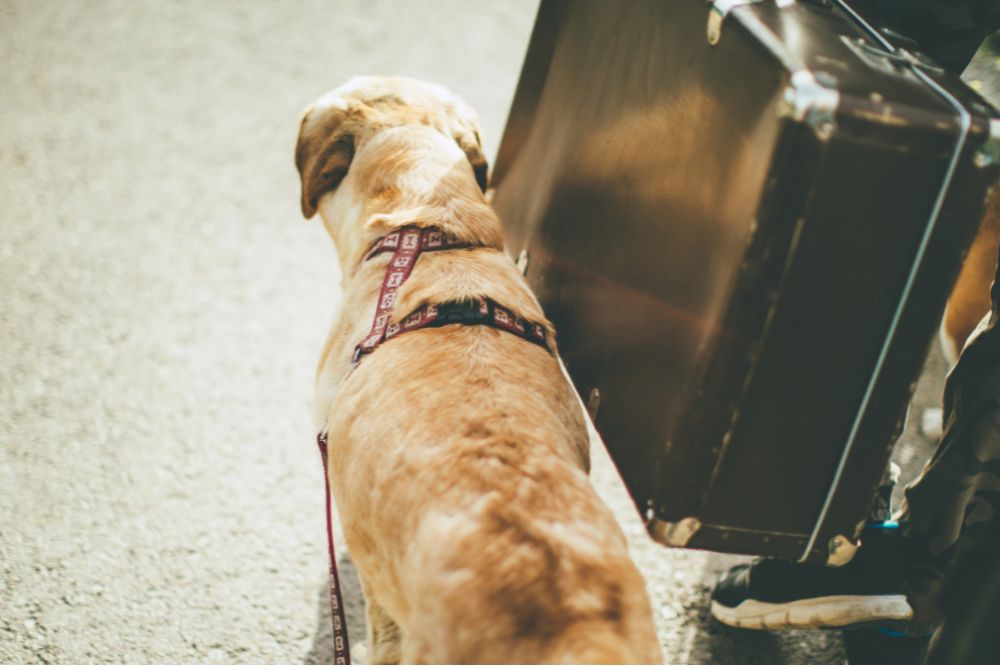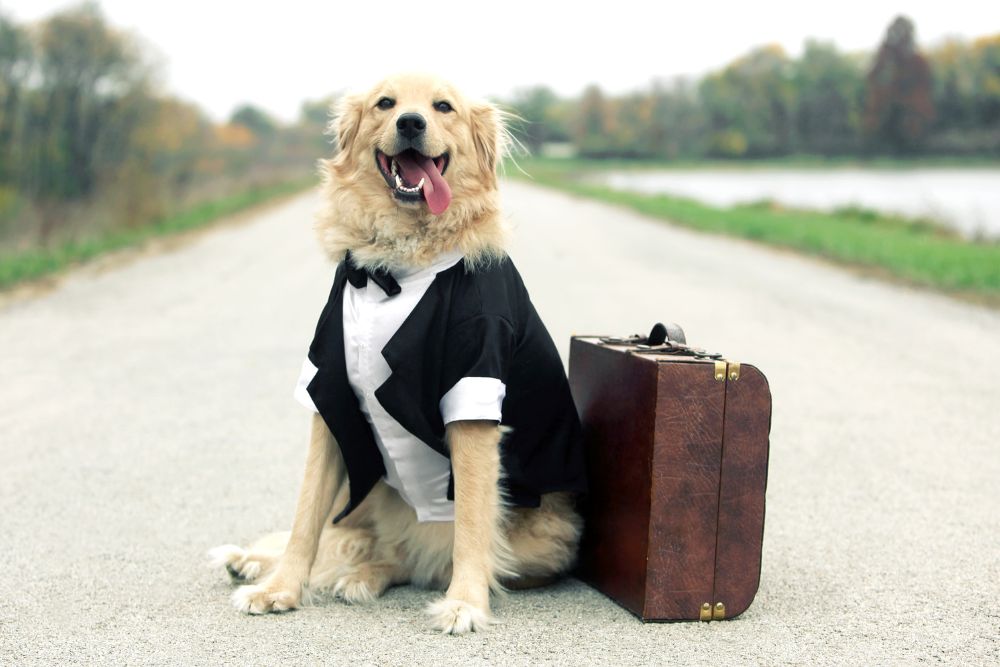Every year, millions of Americans move across and outside of the country. According to the US Census Bureau, 27.1 million Americans relocated in 2021. And with dogs present in more than 69 million households, it’s not surprising that many movers bring their pets along when they relocate.
For small dog breed owners, it’s easy to bring their furry friends into the cabin as carry-on luggage. But if you have a Great Dane or any other breed of large dogs, it’s not as simple as walking into the plane.
If you’re moving or going on a vacation with a large dog, you probably have many questions and concerns on how to go about it. We address all of them below.



Can you bring a large dog on a plane?
CABIN VS CARGO
Small dog breeds can be brought into the cabin provided they’re inside their crate and are crate trained. Typically, they need to weigh 20 lbs. or less, following the airline’s carry-on luggage weight restriction.
If you have a large dog, you can still take them on the plane but not in the cabin. Depending on how large your dog is, they could travel as checked baggage or as cargo.
The first option means your dog is on the same flight but crated and placed in the cargo hold beneath the plane. This is the usual option for medium-sized dogs, and there may be limitations on when you can travel.
Airlines might not allow pets to travel as checked baggage on extremely hot or cold days due to the temperature fluctuations in the cargo hold. There may also be limitations on the number of pets they can carry on a flight.
The second option—large dogs traveling as cargo—is similar to flying as checked baggage. But they are instead placed in a pressurized, temperature-controlled compartment. This is the most comfortable option for large dogs and is ideal even if you’re not traveling on the same plane as them.



PREPARING FOR THE TRIP
1. HEALTH AND VACCINATION DOCUMENTATION
Before flying, your dog needs a trip to the veterinarian within 10 days of your departure date. Airlines will require copies of your dog’s health certificate to ensure their safe and smooth flight.
The health certificate must declare that your pet was examined by a vet and found free of infectious or contagious diseases as these could put other animals and people at risk.
You will also need to present rabies vaccination certification and their breed verification form signed by a licensed veterinarian. The latter is to ensure that your dog is on the approved breed list.
If you haven’t already, you should microchip your canine companion before you depart. It is highly unlikely that the airline will lose track of your dog in transit, but microchipping can offer you peace of mind just in case. Make sure you complete any necessary registration with the microchip company and keep a copy of the relevant documentation on you while you travel.
These are the usual documents that airlines ask for when you’re traveling with a large dog. But for more specific requirements, consult with the airline directly.
2. CHOOSING THE RIGHT AIRLINEPET-FRIENDLY AIRLINES
Most airlines can accommodate pets, including large dogs. According to USA Today, though, the following airlines are the most large-dog-friendly:
- Air Canada
- Air France
- Adria Airways
- Aegean Airways
- American Airlines
- Austrian Air
- Delta Airlines
- Emirates
- Etihad Airways
- Hawaiian Airlines
- Iberia
- LATAM Airlines
- Lufthansa
- Qatar Airways
- Sun Country Airlines
- Swiss International Airlines
- Turkish Airlines
- WestJet
3. DIRECT FLIGHTS VS. LAYOVERS
A few factors will dictate whether it’s better to book a direct or layover flight with your large dog. Generally, a direct flight will be less stressful for you and your dog. However, if your flight is going to be longer than 12 hours, you should consider booking a layover flight to give your dog a break. If you choose a layover flight, check if the airline offers layover pet services or allows you to be with your dog until the next takeoff.
If your destination is in a remote location, the airport is likely only serviced by smaller planes with fewer departure times. This could make traveling with your large dog more expensive and offer you fewer options than major airports. You should also research seasonal weather patterns for when you’re planning to travel. Depending on where you depart and your destination, certain times of the year with extreme temperatures could make it unsafe for your dog to fly. Some airlines will restrict taking pets aboard during very hot or cold seasons due to the potential health risks.
4. COST CONSIDERATIONS
Taking dogs on a plane could require additional fees, especially for large dogs. These fees vary widely, depending on:
- The airline you choose
- Your destination
- The dog’s size
- How your dog is traveling (checked baggage or cargo)
The range of additional fees associated with flying large dogs varies from $200 to over $1000. The exact costs highly depend on the airline’s policies and procedures, so it’s always best to contact the airline you’re interested in before booking your tickets.
Typically, large dogs are only allowed to be flown as checked baggage or cargo. Cargo is the more costly option, but it allows you to fly separately from your dog, and it is easier to track their journey since they are not attached to your passenger ticket. For very large dogs (like Great Danes), you will likely only be allowed to fly them as cargo. Some countries only allow pets to enter as cargo, so be sure to look at your destination’s rules and regulations before finalizing your plans.
You’ve probably already seen the price differences between domestic and international flights. The higher prices of international flights can affect your dog’s transportation fees as well. You can expect to pay at least $200 one-way to fly your dog internationally, with additional costs for layovers and if the airline charges by cargo weight.
SELECTING THE APPROPRIATE CRATE
1. SIZE AND DIMENSIONS
When choosing a crate to fly your large dog in, you have to ensure they have a comfortable amount of room. Remember they are going to be locked up for an extended period by themselves, and giving them some space will make that time much easier for them. This means your dog should be able to stand, sit, fully turn around, and lie down without touching the crate’s walls.
You should also make sure to test locking the crate before you leave. Some crates have pre-installed keypads or locks, and you can attach your own padlock if not. Making sure your dog’s crate locks securely helps prevent your dog from getting loose and stops anyone from interfering with them.
2. COMPLIANCE WITH AIRLINE REGULATIONS
Be sure to know all of your airline’s rules and regulations before choosing your dog’s crate. They may have specific crate size, type, or weight requirements, so make sure you comply to avoid getting turned away at the gate.
Usually, you will be required to attach an identification label to your dog’s crate in a prominent spot. Details on the label should include your contact information, a “live animal” tag, and indicate which side is up to ensure the crate is handled properly. You may even want to attach labels to multiple sides of the crate, just in case.
3. MATERIALS AND DURABILITY
For dogs traveling in cargo or checked baggage, their crate has to be made of a durable, firm material to keep them safe and secure through the flight. Check out the International Air Transport Association’s (IATA) pet crate recommendations to help you ensure the crate you choose is airline compliant.
Plywood crates are an option, although they are much heavier than other plastic or metal options, which can affect your costs if your airline charges by cargo weight. A heavy crate can also make your large dog too heavy for weight restrictions, so it’s good to find a lightweight option when possible.
4. GOOD VENTILATION
Make every effort to ensure that your dog has proper ventilation during the flight. Pet crates include plenty of air holes, and it would be best to avoid covering them up unless necessary for labeling.
While we’re talking about ventilation, you should avoid sedating your dog during the flight. Many airlines will not allow sedated pets because it can alter their breathing patterns. Sedatives can make flying with your dog risky, especially since their condition cannot be actively monitored in the baggage or cargo hold.
5. GIVE YOUR DOG COMFORT
The first step in managing your large dog’s comfort during their flight is getting them used to their crate. Your canine pal should see their crate as their safe space long before they board the plane, which takes time and patience. Once they are familiar and comfortable with their crate, it will be much easier to keep them calm whenever you travel with them. If you don’t normally leave your dog’s crate out at home, try to bring it out at least a week before your departure to let them get reacquainted.
When packing their crate for the flight, remember to include your pup’s favorite items, like toys, blankets, stuffed animals, and more! Although steer clear of small items that could fall out of their crate or accidentally get swallowed.
6. TRAINING YOUR DOG TO USE ABSORBENT PADS
Since your dog cannot be let out during flight, they will have to go in their crate, which isn’t ideal. To keep the mess to a minimum for your dog’s comfort, lay absorbent pads over the bottom of their crate. You may want to train them to use training pads before you leave so they can easily relieve themselves on their long journey.



PACKING ESSENTIALS FOR THE FLIGHT
1. SCHEDULING MEALS BEFORE THE FLIGHT
If you have a large dog, it’s best not to feed them 4 to 6 hours before the flight, especially if it’s a long flight. This reduces the dog’s need to pee or poop while in the air.
Some dogs may get anxious or experience motion sickness while flying. This may cause them to have an upset stomach and vomit, which is another reason they shouldn’t be fed right before a flight.
2. PACKING ENOUGH FOOD AND WATER FOR THE JOURNEY
Your dog’s crate should have two water bowls attached to their crate door. One is for replenishing their water. The other is for placing ice, which gives them ready access to water during the flight.
Airlines don’t feed dogs in transit as the cargo hold will mostly be inaccessible. But for flights with layovers, pack a food dish with a secured small supply of dry food. The airline staff will feed them at designated pet hubs during layovers.
3. ANY NECESSARY MEDICATIONS OR FIRST AID SUPPLIES
This advice applies to anyone who travels, person or pet: remember to label and pack all necessary medications! If your large dog needs medications at certain times, try to adjust their schedule so you can administer their treatment before and/or after the flight without an issue. If you think there will be any cause for concern regarding your dog’s medication, contact your airline directly.
NAVIGATING THE AIRPORT AND SECURITY PROCEDURES
1. ARRIVING AT THE AIRPORT IN ADVANCE
Confirm your booking and any other arrangements 48 hours before your flight to best prepare yourself and the airline for transporting your large dog. It’s extremely important to arrive at the airport at least 2 hours before your flight departs, especially when traveling with pets. However, some airlines have different procedures, so be sure to find out your airline’s arrival and drop-off instructions. If you’re flying internationally, you may need to arrive 5 hours before departure.
Before you check your bags and head through security, remember to take your dog for a walk and find some space to play with them if possible. Exercise will help de-stress your pup and tire them out for the flight. It will also give your dog a chance to relieve themselves before going into their crate.
2. LEASH AND COLLAR REMOVAL
Before you put your canine companion in their crate, remove their leash, collar, and any other restrictive items, including muzzles. Restrictive items in the dog’s crate could cause them to get stuck or have trouble breathing, so airlines do not allow them during the flight.
3. CHECKING IN WITH YOUR DOG
Whether you are flying your large dog as checked baggage or cargo, you will need to bring them to a check-in counter just as you would your bags. Some airlines will direct you to a different area to check your dog in, so be sure to familiarize yourself with the process ahead of time. The airline’s staff will then weigh and move your dog onto the plane.
4. PRESENTING REQUIRED DOCUMENTATION
While you’re checking your dog in, you will need to present the required documentation, which will vary depending on the airline and location. You will need to show applicable USDA-approved vet-issued records and international health certificates, usually dated within 10 days of departure. This will include verification of your dog’s age, breed, and state of health to make sure they are allowed to fly according to the airline’s rules.
You may also need to fill out checklists and wavers related to your dog’s condition, such as when they last ate.
5. DEALING WITH ANY POTENTIAL COMPLICATIONS OR ISSUES
Complications with transporting pets are rare, but we know you’re still going to worry about your beloved pup. In the unfortunate event that something goes wrong with your canine friend’s journey, try to stay calm while you track them down.
Any preventative measures you take before checking your dog in will help in case of an emergency. Clearly labeling the crate with your full contact information will help the airline get your dog back to you. If your dog is microchipped, you can notify the microchipping company of the issue and keep in contact with them in case someone finds your lost pup.
Check in often with the airline for updates and tell them any relevant information as soon as possible. It might also help to have a picture of your dog to show airline employees.
Again, complications with flying with your dog are highly unlikely! However, following the recommendations of airlines, regulatory agencies, and professionals like us will help you sort out any potential issues.
ALTERNATIVE TO TRANSPORTING A LARGE DOG
Changes in temperature, especially in the cargo hold, along with pressure changes that make ears pop can affect your dog. As such, most experts do not recommend flying as a mode of transport, especially for large dogs.
If you want to relocate with your dog and not have to worry about everything mentioned above, it’s best to consult with reliable dog transport companies.
Dog transportation services are specially designed to keep man’s best friend safe and comfortable during travel. At Pet Van Lines, we provide pet transportation services for large dogs using spacious, climate-controlled SUVs or minivans.
With these services, you don’t have to worry about size and breed restrictions, food, and the overall comfort of your beloved dog. Our drivers are trained in handling dogs, making sure they get to eat, rehydrate, and exercise during long drives.If you want a safe and hassle-free pet transportation option, contact Pet Van Lines for a free quote today.

